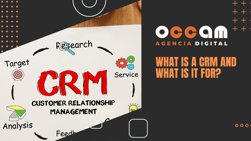Index Content
To carry out a digital marketing strategy there are many aspects to take into account to ensure that the actions we carry out meet the objectives.
Often all these strategies generate a large amount of data and information that can overwhelm you. This is where elements such as the dashboard come in.
Don't worry if you haven't heard of it before, today we'll explain everything about this tool. Keep reading so you don't miss anything!
what is a dashboard?
A dashboard, also known as a scorecard or control panel, is a tool for managing information, and is a graphical representation of the metrics or KPIs and the fundamental data involved in monitoring the company or a specific campaign.
In other words, it is a screen that offers a visual representation of the most relevant data to provide an overview and check in real time whether the actions are working or not.
It is a tool that allows you to visualise the data, so you can see if there are problems and thus make better decisions and avoid mistakes. Its main purpose is to have a graphical presentation of the data so that they are useful information for the company and thus properly guide the strategy towards the objectives set.
what should a dashboard look like?
For a dashboard to be correctly designed, it must have the following characteristics:
- contain the right KPIs. Not all metrics are necessary, you have to choose those that make sense with the campaign you are carrying out and with its objectives. For example, if you are using a social media strategy, it is useless to use metrics aimed at sales. Choose those that provide value and allow you to make better decisions.
- it must be visual: A good dashboard has to be an orderly, clean and simple graphic, so that at a glance you can understand the data displayed. It is an element that is created to facilitate, not to complicate your work. To do this, it uses indicators such as dates, colours, highlights, etc.
- practical: Its main function is to guide the company and the teams, so it has to provide the necessary information to improve and follow the steps towards the objective.
- Personalised: Like any other digital marketing strategy, a dashboard is not a static element, nor is it the same as any other company's. It can be personalised as the campaign progresses, and you should always create it according to your objectives.
- the information must always be updated, because digital marketing is constantly evolving and your actions can change.
what is a dashboard used for?
You already know what a dashboard is and what this graphical representation should contain, now we will focus on what it is used for. Among its main uses are:
- to give value and accessibility to data. Data and information are an essential and valuable element of a brand or company, so with the dashboard you give value to the main metrics. Thanks to the representation of them, the whole team can consult them when needed. It is a file that has to be accessible to all members of a company, who also consult them in real time.
- you include all the teams in the company. By having a document that can be consulted by all the workers, you favour collaboration and improved communication. It is not an element that only the marketing department has access to, but if the sales or customer service department needs it, they can consult it. In the same way, everyone knows how the actions are going because they know the results of the KPIs.
- better understanding: As it is a visual and clear representation of the data, it is easier to understand without the need to be an expert in analysis.
- it allows us to have a global vision of the KPIs. On many occasions we carry out several campaigns at the same time and of a certain complexity, which leads to having to analyse several things at the same time. These analytics are usually obtained from different platforms, and having to look at each one of them is a task that takes time. By having a control panel where we collect the most important data, we do not waste time looking at the metrics of the campaigns separately, we have it all in a single document.
- easier to understand and more efficient reports. As we told you in the previous point, a dashboard is a tool that will save you time and effort. It is true that you invest time in creating this document, but it is only at the beginning, once you have it created the only thing you will have to do is to update it if necessary. And being a visual document, organised, with graphs and the essential elements, it is easier to understand.
In conclusion, to measure the success of all your digital marketing actions, the first thing you should do is to choose the main KPIs that fit your objectives. Remember that your objectives must be SMART (specific, measurable, achievable, relevant and temporary). Once you have this clear, it is time to set up your dashboard, which will be a fundamental tool to help you monitor your strategies.
We hope that now that you know the advantages of creating a dashboard, you will be encouraged to use this tool in your company.
we hope you have enjoyed reading this article!





